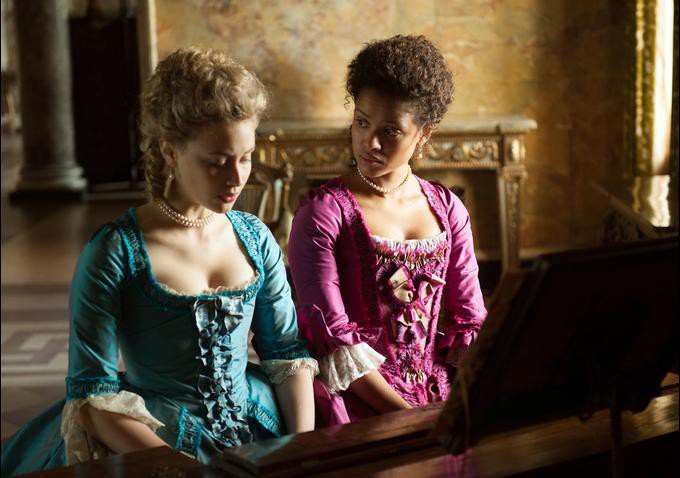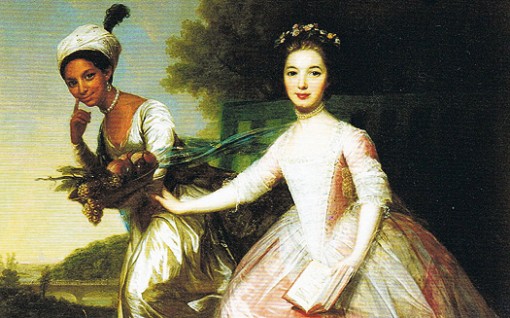
There’s nothing quite like Belle on the contemporary film scene — a luxurious period film and a sweet, gentle romance that wears its keenly insightful politics on its silk sleeves. Belle is the sophomore feature from black British director Amma Asante, who was finally able to realize her decades-long wish to first star in, and later write and make, a Jane Austen-esque period film when she came across a portrait of Dido Elizabeth Belle, an 18th-century half-African, half-British historical noblewoman.
The following is the first of two interviews we’ll publish on Women and Hollywood with Asante; the next half will run tomorrow. Though the film’s interlocking themes of race, gender, and class make those themes difficult to pry apart, the first-parter focuses more on gender, love, and the origins of the film, and the second-partner on race, history, and the fascinating behind-the-scenes details of period filmmaking.
Belle will be released in the US on May 2.
How did
you found Dido the real person?
I had been an actress in my childhood years and
obsessed with period movies, but you never see a person of color in them
unless they’re a servant or a slave. I always wondered what it would be like to
tell a story with a black female lead who wasn’t a slave,
and what it would be like to be in one of those stories. Then my career
transitioned and I became a writer and director and I felt the same thing.
The British Film Institute (BFI), who have financed
all my films, knew that I was obsessed with this 18th-century
period. When [producer] Damian [Jones] came to them and said, “I really want to
do a movie about this woman Dido,” the BFI said
to him, “You know, Amma is obsessed
with the period. She’s dying to make a Austenesque [film] that has a black
lead.”
But I had never found the story that I could
hang my hook on. I had never found my window into an authentic way to tell this
story, so when Damian came to them they
put us together.
When I saw this postcard print of Dido — which now hangs
in Scone Palace and periodically comes back to hang in Kenwood House, where Dido was brought up — I looked at it and thought, “Wow. This is
pretty incredible.” I knew nothing really about her upbringing, why she was in
the painting, why she was dressed as an aristocrat, why she was in silks wearing jewels, and why she looked as confident as she does. Obviously,
I knew it was an 18th century painting and I knew, because of
previous research I had done in art, that this painting was completely unusual.
From there I decided that I had to embark on
some research and find out more about her. The postcard just
triggered a huge fascination and I had to start digging and digging and
digging.
You
mentioned before that you had previously been an actress in the early part of
your career. Did you ever consider playing Dido yourself?
No, never. I’m in my 40s; Dido is about 20 in
the story. That’s the first thing. Secondly, I was never a very good actress. What acting did for me, really, was [serve as] a
great introduction to writing and directing. It was really my way in
understanding what my strengths were, but also what my passion is, which is
writing and directing, and facilitating good performances.
I also knew that Dido should be very easily
identifiable as half black and half white, which I’m not. The fact that she’s
half black and half white was really important to the story for many reasons — because Dido is kind of half of everything in the movie: she’s the child of an
aristocrat and she’s the child of an African slave; she both has one foot in and one foot out.
It needed to be very clear throughout the story
that she was as much white as she is black — — that she always looked mixed
race. I [also] think it’s really important [to show that] even though she’s a
woman color onscreen, this history belongs to all of us: it’s both black
history and white history. Dido very much belongs to all of us and
she’s about all of our history.
Why did
you decide to go the route of the Austenesque romance to tell her story?
In so many ways, it’s a romantic love story and it’s a paternal love story as well. It’s as much about her and [her
surrogate father] Lord Mansfield, and also the fact that
her biological father loved her as well.
It was
much more practical in those days, if you had an illegitimate child of
color, you could bring them into the household but had to keep them in the servant’s quarters, and have them work
with servants where they’d be safe but wouldn’t be a full part of the
family. The fact that her father decided that he didn’t want her to be brought
up that way and brought her to his uncle [Lord Mansfield] and said, “Love her
as I would had I been here,” was important to me.
When I did the research, it surprised me how
many people had left Dido money in their will — Lord Mansfield left her money
in his will [and] Lady Mary, Lord Mansfield’s sister, also left Dido in her
will. The reality of it, then, was that so many people clearly [and] on paper
showed their love for Dido that I thought it would have been disingenuous for
me to tell a story purely about her suffering and a story that wasn’t about her
love.
She had great love. That she married John Davinier, that she was able to baptize all of
her children with him in the same church that they married in, I found that
that was very romantic and beautiful.
I also wanted to understand, or communicate to
the audience, what kind of men would love Dido during this period. Lord
Mansfield, who adopted her, and also John [her husband] — what would make them
so brave and so courageous enough to be able to love this woman of color during
that period?
If I’m honest, I wanted to show a woman of color
being loved. We don’t see it that often. I wanted to change the conversation a
little bit, change the dialogue a little bit — we are loved, [and] we can be
loved. Dido was valuable enough to be loved, she was worthy of being loved, and
she was loved. Her challenge was showing people the right way to love her in
the way that she needed to be.
How did
you decide upon the interlocking structure of the race, gender, and class
critiques? It was so smart and so touching to see how everyone was oppressed in
particular ways.
The three subjects that you’ve mentioned — race,
gender, and class — are quite important to me, and they also feature in my
first movie [A Way of Life]. I was
very taken with the idea of how race at the time paralleled in some way with
the story of being a woman. You know, the reason it’s tradition that women take
their husband’s last name is that back then the man owned his wife in the same
way that he owned his horses and his slaves. The ownership issue was very much
a big one for me.
She’s not just wealthier than mainly all black
people, if not all black people, during that period. She’s also wealthier than
most white people because most white people during that period were servants
and peasants. When I looked at the painting, to me, this was a woman who was
free twice over. As that thought came to me — “Oh my God, she’s both rich and
she’s not a slave” — I [realized] this a story in which all of these things
have to be entwined.
Did you ever worry that the characters might come across as
maybe too modern?
No, I
didn’t worry that they would come across as too modern in the sense that the
first thing financers ask you when you want to tell a story that’s period or
historical is, “Why now? Why is this story relevant today?” [They’re] always
looking for the answer to that question — what the parallels are with today.
I
didn’t worry that they’d be too modern, but I did worry, for instance, about
how I could ensure that Dido didn’t come across as spoiled, or demanding: “How
can I make sure that the audience will understand the Dido, this privileged
woman who appeared to have a lot yet still appeared to be asking for more, how
can I make it clear that she wasn’t asking for more — [that] she was actually
asking for equality?”
When you were doing your historical research did you get any
sense of Dido’s personality?
The
feisty personality that you see as Dido’s was very much a decision that I made
at the very beginning of the project. I wanted Dido to be a character that goes
from girl to woman, a character that goes from saying, “As you wish, sir” to
one who says “As I wish,” and somebody who definitely grows, so that when she
stands her ground it doesn’t come as a shock.
I studied the picture for a long time, and I still stare at the painting — even today, I find myself staring at the painting.
What I did glean from the painting, from the very moment Damian, the producer
sent it, was that to me, she just looked so
confident.
Generally
in these paintings, the black character in the painting is never looking at the
painter. They’re always looking up at the white muse in the painting; they’re
always situated lower down in the painting and looking up in awe at the white
main protagonist. They’re very much like pets in the painting, background
characters who are there to show the status of the white main muse.
When I
looked at this painting of Dido, she looked so confident and strong. She’s
actually painted slightly higher than [her white surrogate sister] Elizabeth
and she’s looking directly at the
painter, which is something you never see in these 18th century
paintings where a person of color is painted next to a Caucasian person. The
strength with which she looks back at us, and the confidence in which she’s
pointing to her own face and looking rather happy with herself — I took that as
strength. I took that as my landing place for her: where I wanted her to end
the film as opposed to where I wanted her to start the film.
I also
took from general history that a woman who had been brought up in such a
household with a good education, relatively wealthy, wearing nice clothes and
with a father who was very prominent and very high status, probably would’ve
been pretty confident. Again, I didn’t want to portray yet another female and
yet another person of color onscreen as meek, mild, sad. I really wanted to
present a character, a woman of color, who could speak up for herself — and who
learned to do that.
Previously: Athena FF: Amma Asante’s Belle Revisits Jane Austen Through Black POV







